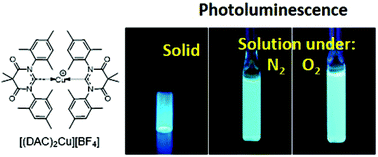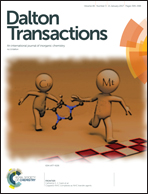Synthesis and characterization of phosphorescent two-coordinate copper(i) complexes bearing diamidocarbene ligands†
Abstract
The photophysical properties of four, two-coordinate, linear diamidocarbene copper(I) complexes, [(DAC)2Cu][BF4] (1), (DAC)CuOSiPh3 (2), (DAC)CuC6F5 (3) and (DAC)Cu(2,4,6-Me3C6H2) (4) (DAC = 1,3-bis(2,4,6-trimethylphenyl)-5,5-dimethyl-4,6-diketopyrimidinyl-2-ylidene) have been investigated. Complex 1 shows a high photoluminescence quantum efficiency (ΦPL) in both the solid state (ΦPL = 0.85) and in CH2Cl2 solution (ΦPL = 0.65). The emission band of 1, both as a crystalline solid and in solution, is narrow (fwhm = 2300 cm−1) relative to the emission bands of 2 (fwhm = 2900 cm−1) and 3 (fwhm = 3700 cm−1). Complexes 2 and 3 are each brightly luminescent in the solid state (ΦPL = 0.62 and 0.18, respectively), but markedly less so in CH2Cl2 solution (ΦPL = 0.03 and <0.01, respectively). Complex 4 is not emissive in either the solid state or in solution. Phosphorescence of 1 in CH2Cl2 solution shows negligible quenching by oxygen in CH2Cl2 solution. This insensitivity to quenching is attributed to the excited state redox potential being insufficient for electron transfer to oxygen.



 Please wait while we load your content...
Please wait while we load your content...